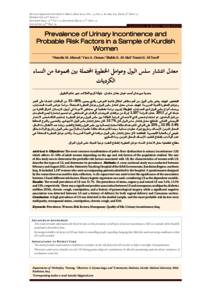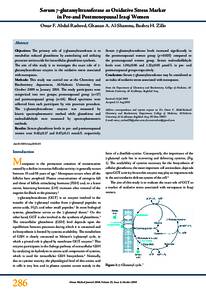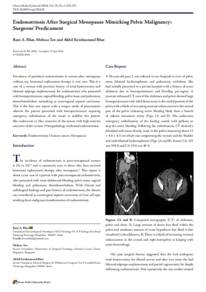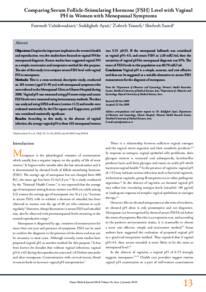Document
Prevalence of urinary incontinence and probable risk factors in a sample of Kurdish women.
Contributors
Other titles
معدل انتشار سلس البول وعوامل الخطورة المحتملة بين مجموعة من النساء الكرديات.
Publisher
College of Medicine, Sultan Qaboos University.
Gregorian
2013-05
Language
English
Subject
English abstract
Objectives: The most common manifestation of pelvic floor dysfunction is urinary incontinence (UI) which affects 15–50% of adult women depending on the age and risk factors of the population studied. The aim of this study was to determine the probable risk factors associated with UI; the characteristics of women with UI; describe the types of UI, and determine its prevalence. Methods: A cross-sectional study was conducted between February and August 2011, in the Maternity Teaching Hospital of the Erbil Governorate, Kurdistan Region, northern Iraq. It included 1,107 women who were accompanying patients admitted to the hospital. A questionnaire designed by the researchers was used for data collection. A chi-square test was used to test the significance of the association between UI and different risk factors. Binary logistic regression was used, considering UI as the dependent variable. Results: The overall prevalence of UI was 51.7%. The prevalence of stress, urgency, and mixed UI was 5.4%, 13.3% and 33%, respectively. There was a significant positive association between UI and menopause, multiparity, diabetes mellitus (DM), chronic cough, constipation, and a history of gynaecological surgery, while a significant negative association was detected between UI and a history of delivery by both vaginal delivery and Caesarean section. Conclusion: A high prevalence of UI was detected in the studied sample, and the most probable risk factors were multiparity, menopausal status, constipation, chronic cough, and DM.
Member of
Resource URL
Citation
Ahmed, Hamdia M., Osman, Vian A., Al-Alaf, Shahla K. & Al-Tawil, Namir G. (2013). Prevalence of urinary incontinence and probable risk factors in a sample of Kurdish women. Sultan Qaboos University Medical Journal, 13 (2), 269-274.
Arabic abstract
الملخص: الهدف: يعتبر سلس البول من أهم مظاهر اعتلال قاعدة الحوض، والذي يصيب %50-15 من البالغات اعتمادا على العمر وعوامل الخطورة للعينة المدروسة. الهدف: حساب معدل انتشار سلس البول وعوامل الخطورة المحتملة، دراسة خواص النساء المصابات، ووصف أنواع سلس البول لدى المصابات. الطريقة: إجريت دراسة مقطعية في مستشفى الامومة في أربيل، کردستان العراق للفترة من شباط الى آب 2011. شملت الدراسة 1,107 إمرأة من مرافقات المريضات الراقدات في المستشفى. تم تصميم إستمارة لجمع المعلومات من قبل الباحثين. تم استخدام فحص كاي الاحصائي لدراسة العلاقة بين سلس البول وعوامل الخطورة. إستخدم كذلك فحص الانحدار اللوجستي الثنائي. النتائج: معدل إنتشار ساس البول كان %51.7. كان معدل إنتشار سلس البول الاجهادی، والعصبي، والنوع المختلط 5.4%، 13.3%
، و %33 على التوالي. كانت هناك علاقة معتدة إحصائيا بين سلس البول وإنقطاع الطمث، زيادة عدد الأطفال، داء السكر، السعال المزمن، الإمساك، وتاريخ إجراء عمليات نسائية. بينما كانت هناك علاقة عكسية (سالبة) بين سلس البول وتاريخ الولادة بشكل
طبيعي أو بالعملية القيصرية. الخلاصه: كان معدل إنتشار سلس البول مرتفعا في العينة المدروسة، وكانت عوامل الخطورة المحتملة هي تعدد الولادات، إنقطاع الطمث، الإمساك، السعال المزمن، وداء السكري.
، و %33 على التوالي. كانت هناك علاقة معتدة إحصائيا بين سلس البول وإنقطاع الطمث، زيادة عدد الأطفال، داء السكر، السعال المزمن، الإمساك، وتاريخ إجراء عمليات نسائية. بينما كانت هناك علاقة عكسية (سالبة) بين سلس البول وتاريخ الولادة بشكل
طبيعي أو بالعملية القيصرية. الخلاصه: كان معدل إنتشار سلس البول مرتفعا في العينة المدروسة، وكانت عوامل الخطورة المحتملة هي تعدد الولادات، إنقطاع الطمث، الإمساك، السعال المزمن، وداء السكري.
Category
Journal articles




